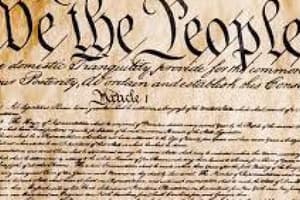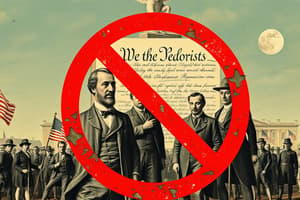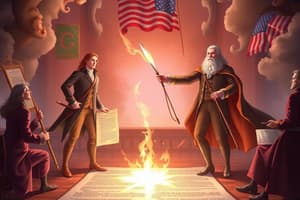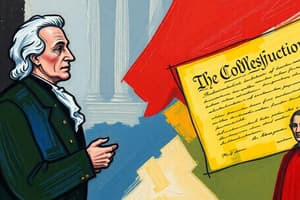Podcast
Questions and Answers
Which of the following best describes the primary difference in the structure of government favored by the Federalists and Anti-Federalists during the debate over the ratification of the U.S. Constitution?
Which of the following best describes the primary difference in the structure of government favored by the Federalists and Anti-Federalists during the debate over the ratification of the U.S. Constitution?
- Federalists supported direct democracy with frequent popular votes, whereas Anti-Federalists favored representative government.
- Federalists argued for term limits on elected officials, an idea the Anti-Federalists strongly opposed.
- Federalists advocated for a strong, centralized national government, while Anti-Federalists preferred a system where states retained significant autonomy. (correct)
- Federalists wanted a government with no standing army, while Anti-Federalists believed a strong military was essential for national defense.
The Anti-Federalists were strong supporters of the Constitution as it was originally written, believing it provided sufficient protection for individual liberties.
The Anti-Federalists were strong supporters of the Constitution as it was originally written, believing it provided sufficient protection for individual liberties.
False (B)
What key event demonstrated the weakness of the Articles of Confederation and ultimately spurred the movement to create a new constitution?
What key event demonstrated the weakness of the Articles of Confederation and ultimately spurred the movement to create a new constitution?
Shays' Rebellion
A major point of contention between the Federalists and Anti-Federalists was the power of the federal government; Federalists favored a strong national government, while Anti-Federalists feared _________ and preferred more power be retained by state governments.
A major point of contention between the Federalists and Anti-Federalists was the power of the federal government; Federalists favored a strong national government, while Anti-Federalists feared _________ and preferred more power be retained by state governments.
Match each group with their stance on the new Constitution:
Match each group with their stance on the new Constitution:
Which of the following best describes the main argument of the Anti-Federalists against the Constitution?
Which of the following best describes the main argument of the Anti-Federalists against the Constitution?
Federalists advocated for a narrow interpretation of the Constitution to limit the power of the national government.
Federalists advocated for a narrow interpretation of the Constitution to limit the power of the national government.
What was the primary purpose of The Federalist Papers?
What was the primary purpose of The Federalist Papers?
The Anti-Federalists primarily appealed to the average ______, while the Federalists appealed to the elite.
The Anti-Federalists primarily appealed to the average ______, while the Federalists appealed to the elite.
Match each Federalist or Anti-Federalist leader with their respective political faction.
Match each Federalist or Anti-Federalist leader with their respective political faction.
Which of the following best describes the economic vision of the Federalists?
Which of the following best describes the economic vision of the Federalists?
Anti-Federalists generally favored closer diplomatic ties with England over France.
Anti-Federalists generally favored closer diplomatic ties with England over France.
What is the meaning of 'ratify'?
What is the meaning of 'ratify'?
Federalists wanted to ______ voter qualifications, whereas Anti-Federalists wanted to lower them.
Federalists wanted to ______ voter qualifications, whereas Anti-Federalists wanted to lower them.
Which concession was made to the Anti-Federalists that led to the ratification of the Constitution?
Which concession was made to the Anti-Federalists that led to the ratification of the Constitution?
Which of the following best explains why the U.S. Constitution includes the Bill of Rights?
Which of the following best explains why the U.S. Constitution includes the Bill of Rights?
Federalists believed a Bill of Rights was essential to protect individual liberties from government intrusion.
Federalists believed a Bill of Rights was essential to protect individual liberties from government intrusion.
Which group favored a stronger national government and a unified economic policy during the ratification debates?
Which group favored a stronger national government and a unified economic policy during the ratification debates?
The Anti-Federalists primarily feared that the new Constitution would give too much power to the ________ government.
The Anti-Federalists primarily feared that the new Constitution would give too much power to the ________ government.
Match each power with the appropriate level of government:
Match each power with the appropriate level of government:
Which of these is an advantage the Federalists had over the Anti-Federalists during the ratification debate?
Which of these is an advantage the Federalists had over the Anti-Federalists during the ratification debate?
The 10th Amendment reserves all powers not delegated to the federal government, nor prohibited to the states, to the states respectively, or to the people.
The 10th Amendment reserves all powers not delegated to the federal government, nor prohibited to the states, to the states respectively, or to the people.
What is the main focus of the 1st Amendment?
What is the main focus of the 1st Amendment?
The right to bear arms is protected by the _______ Amendment.
The right to bear arms is protected by the _______ Amendment.
Which amendment protects citizens from unreasonable searches and seizures?
Which amendment protects citizens from unreasonable searches and seizures?
The 5th Amendment prevents the government from taking private property for public use without providing just compensation.
The 5th Amendment prevents the government from taking private property for public use without providing just compensation.
What does the 8th Amendment prohibit?
What does the 8th Amendment prohibit?
The _______ Amendment guarantees the right to a speedy and public trial.
The _______ Amendment guarantees the right to a speedy and public trial.
Which action is permitted under the powers granted to BOTH the federal and state governments?
Which action is permitted under the powers granted to BOTH the federal and state governments?
Which political party evolved from the Anti-Federalists?
Which political party evolved from the Anti-Federalists?
Flashcards
Ratify
Ratify
To officially approve or accept a document or agreement.
Federalists
Federalists
Favored a strong national government and the U.S. Constitution.
Anti-Federalists
Anti-Federalists
Advocated for more power to the states and individual liberties; opposed the Constitution as it was initially written.
Alexander Hamilton
Alexander Hamilton
Signup and view all the flashcards
Broad Interpretation (of Constitution)
Broad Interpretation (of Constitution)
Signup and view all the flashcards
Narrow Interpretation (of Constitution)
Narrow Interpretation (of Constitution)
Signup and view all the flashcards
The Federalist Papers
The Federalist Papers
Signup and view all the flashcards
Anti-Federalist Stance
Anti-Federalist Stance
Signup and view all the flashcards
Federalist Supporters
Federalist Supporters
Signup and view all the flashcards
Bill of Rights
Bill of Rights
Signup and view all the flashcards
Articles of Confederation
Articles of Confederation
Signup and view all the flashcards
Confederation
Confederation
Signup and view all the flashcards
Federal
Federal
Signup and view all the flashcards
Constitution
Constitution
Signup and view all the flashcards
Shays' Rebellion
Shays' Rebellion
Signup and view all the flashcards
Interstate/Foreign Trade (Federal)
Interstate/Foreign Trade (Federal)
Signup and view all the flashcards
Intrastate Commerce (State)
Intrastate Commerce (State)
Signup and view all the flashcards
Taxation (Federal & State)
Taxation (Federal & State)
Signup and view all the flashcards
Pass Laws (Federal & State)
Pass Laws (Federal & State)
Signup and view all the flashcards
Foreign Relations (Federal)
Foreign Relations (Federal)
Signup and view all the flashcards
Local Governments (State)
Local Governments (State)
Signup and view all the flashcards
1st Amendment
1st Amendment
Signup and view all the flashcards
2nd Amendment
2nd Amendment
Signup and view all the flashcards
3rd Amendment
3rd Amendment
Signup and view all the flashcards
4th Amendment
4th Amendment
Signup and view all the flashcards
5th Amendment
5th Amendment
Signup and view all the flashcards
10th Amendment
10th Amendment
Signup and view all the flashcards
Study Notes
- Document that governed the colonies during and briefly after the Revolution was the Articles of Confederation.
- Confederation refers to a loose union of countries or states similar to an alliance.
- America's first federal Constitution.
- Federal refers to national.
- Constitution represents as a document outlining government operations and serves as the highest law of the land.
- Each state had one vote under the Articles of Confederation.
- States retain the authority to engage in treaty-making and declaring war.
- Requiring a two-thirds majority to pass laws.
- Absence of a president or Supreme Court.
- States possessed the power to issue currency which led to differing currencies and inflation.
- Shay's Rebellion involved Massachusetts farmers forming a militia and rebelling due to high taxes.
- Congress lacked the authority to act, prompting recognition of the necessity for a stronger federal government and resulted in replacing the Articles with the Constitution.
Constitutional Compromises
- Representation in Congress
Virginia Plan
- Bicameral legislature.
- Two houses of Congress.
- One house is based on the state's population, which selects members for the other smaller house.
New Jersey Plan
- Unicameral legislature.
- All states get same number of representatives, regardless of population.
The Great Compromise
- Bicameral legislature.
- Congress includes both Senate and House.
- Each state has two senators for the Senate and representation in the House depends on population.
Electing President
Direct Election
- The candidate with the most votes becomes President.
- States make decisions due to mistrust of common voters.
Electoral College
- Each state gets electors who cast votes for president.
- Number of electors per state corresponds to its population size.
- State-level popular vote determines the allocation of electoral votes.
- Majority of electoral votes wins the election.
- Smaller states receive consideration from candidates.
- Electors can ignore the popular vote, though almost never occurring.
3/5 Compromise
- Northern states were against counting slaves as people whereas Southern states wanted to count them so they had more representatives in the South.
- Every five slaves were counted as three people for census purposes.
Slavery
- Southern states wanted to count slaves as people while Northern states wanted to end slavery.
- The slave trade with Africa ended in 1808.
- Runaway slaves are required to be returned to their enslavers.
Preamble
- It serves as the introduction to the Constitution, stating its goals.
- It starts with “We the People".
Three Branches of Government
- There is a designed separation of powers.
- Government divides into three branches.
- Branch has distinct roles to prevent any single entity from gaining excessive power.
- There exists a system of checks and balances as part of separation of powers.
- Each branch can check, or block, action of other branches to prevent too much power.
Legislative Branch
- Congress, House of Representatives, and Senate.
Executive Branch
- President, Vice President, Cabinet, Army, police.
- Different groups write legislation, the executive approves, and the judicial judges laws.
Judicial Branch
- A court system led by the Supreme Court (itself led by the Chief Justice).
- Popular represents the total number of votes someone gets.
- Electoral College works by each state getting votes based on it's population size, such as California which get 55, and Alaska gets 3.
- The winner of most electoral votes becomes the President even if they didn't win the popular vote.
Vice President
- Takes over if President dies.
- Break a tie vote in the Senate.
Speaker of the House
- In charge of the House of Representatives.
- Becomes president if the President and Vice President die.
Senate Majority Leader
- In charge of the Senate.
- Impeachment occurs when Congress makes a decision for a President/Supreme Court justice to get put on trial.
- Removal forces a president/Supreme court Justice to vacate their job.
Checks and Balances
These checks and balances have various controls that they possess to ensure power isn't abused by one entity:
Executive
- Enforces laws
- What is it:
- President, cabinet, secretary of state, homeland security etc
- Four year term, can be elected twice. Natural born, and 35+ years old
- Natural-born citizen
- Commander in Chief of all armed forced (military)
- Appoints Supreme Court, Cabinet. Can pardon, or free, someone from prison.
Legislative
- Makes Laws
- Congress; House of Representatives and Senate:
- House of Rep: 2 year term, with state population dictating how many it gets.
- Senate: 6 year term, 100 total, 2 from each state.
- No term limits. Congressman needs to be 25+, living where they are representing. Senator needs to be 30+, living where they are representing
- Raise money through taxes
- Declare war and raise an army
- Impeach or remove the President/Supreme court for wrong doing.
- Approves Presidential appointments (Supreme Court, cabinet) with majority vote.
- Has the power to veto laws Congress passes and override presidential vetoes (with 2/3 of houses)
- Power of the purse, budgetary control dictating where money should be spent
Judicial
- Interprets laws
- Supreme Court (And other courts)
Requirements
- Appointed (picked) by president . Serve a life term. 9 justices, including Chief Justice.
- Reviews cases of lower courts-final court of appealing (highest you can go)
- Settles arguments betweens states
- Can declare laws Presidential actions unconstitutional
Necessary and Proper Clause (Elastic Clause)
- The framers knew the Constitution may not apply to every and any problem.
- This clause gives Congress power to "make all Laws which shall be necessary and proper" for the nation
- Congress can thus pass laws not in the Constitution (flexible)
Bill
- Suggestion for a law
- How a bill becomes a law is a prime example of checks and balances in government. To make an amendment (change to Constitution), it needs 3/4 of the states to approve it.
- Ratify means to approve or accept.
- Federalists want a strong national/federal government. Alexander Hamilton, James Madison, and John Jay wrote "The Federalist Papers" to try and convince people the pros of their beliefs.
Anti-Federalists
- Wanted the states and people to have more power, compared to the federal government.
Federalists
- Included Alexander Hamilton, Ben Franklin, John Adams, John Jay, James Madison, and George Washington.
- Were pro-business
- Wanted a national bank
- Were appealing to the wealthy and powerful
- Wanted to raise voter qualifications, meaning fewer people could vote
- Supported England
- Believe strong federal government is how it should be. They believed people were selfish and would abuse power. Want a broad interpretation of the Constitution
Anti-Federalists
- Included Thomas Jefferson, Patrick Henry.
- Were pro-farming
- Opposed a national bank.
- Were appealing to the average Joe.
- Wanted to low voter qualifications, meaning its easier to vote for those who wish too.
- Supported France
- Weak national government, noble savage. They thought there wasn't enough individual liberty in Constitution and gave government too much power. They wanted a narrow interpretation. When realized would lose, gave up when fighting constitution and supported the Bill of Rights.
Federal & State Powers
- Became Federalist party as Feds listened to anti-Feds.
- Became Democratic-Republican party
- Supported Bill of Rights.
Federal Powers
- Interstate & foreign trade
- Foreign relations
- Declare war
- Coin money
- Immigration
- Postal
State Powers
- Intrastate commerce
- Local governments
- Public health
- Voter qualification
- Supervise elections
- Education
- License jobs
- Marriage laws
Both
- Taxation
- Pass laws
- Borrowing
- Courts
- Law enforcement; punish lawbreakers
- Banks
- Roads
Amendments
- Amendment 1: Freedom of religion, speech, the press, the right to assemble
- Amendment 2: Right to bear arms
- Amendment 3: No quartering (Can't make citizens house soldiers in homes)
- Amendment 4: No searches and seizures. Police can't search home or take property without a warrant signed permission from a judge
- Amendment 5: Right to remain silent, can't be put on trail twice for same crime, and government can't take private property for public use, without paying a fair price
- Amendment 6: Right to a speedy and public trail
- Amendment 7: Right to trail by jury
- Amendment 8: No cruel and unusual punishment
- Amendment 9: These rights don't deny other rights (This is nota complete list)
- Amendment 10: All other powers are left to states or those who are people.
Studying That Suits You
Use AI to generate personalized quizzes and flashcards to suit your learning preferences.




